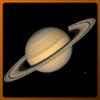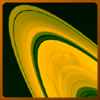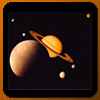You are seeing this message because you are using an out-of-date browser.
Please click here for more information.
The Solar System's "Lord of the Rings"
Saturn has been a source of wonder and amazement for Earth dwellers since ancient history. This sense of wonder increased in 1610 when Galileo turned his first telescope on this giant planet and was the first person to see Saturn's beautiful ring system.
What Galileo saw, although he didn't see it clearly, was the beautiful system of rings that surround the giant planet. His early telescope wasn't good enough to show details in the rings, so he wasn't quite sure what he was seeing, but he certainly realized that it was something very special. (Saturn was the first planet I ever saw through my telescope and I will never forget how stunning it was to see the rings for the first time.)
The advantage that we have now is that we can see the rings of Saturn using almost any moderately priced telescope. A good telescope allows us to see that there isn't just one ring around Saturn, but that what appears to be one ring through a low powered telescope is revealed as a complicated system of rings through a good telescope.
So Light it Floats!
Saturn is the sixth planet from the Sun and the second-largest planet in our solar system. Only Jupiter is larger. In spite of it's giant size, though, Saturn doesn't weigh very much. In fact, as a whole,Saturn is lighter than water and would float in a bathtub if you had one big enough (of course the water bill would be extremely high).
Another interesting side effect of Saturn's low density is the fact that is actually "flattens out" at it's equator, which you can clearly see in the full-size images of the planet on this page. Saturn's day is only a little more than ten hours long, which means that it rotates very quickly. The combination of it's high rotation speed and low density makes the planet flatten out or "oblate" at its equator.
Saturn's Rings
Until the Voyager missions visited Saturn, about all we knew about the rings was that they were exceptionally beautiful and had a large gap in them called the Cassini Division. By the time the Voyager spacecraft left the ringed planet, we knew that the ring system was very complex and was actually made up of many, many separate rings, including one ring that appeared to be "braided". In addition, we had learned that the appearance of the rings could change. One of the more interesting and puzzling features of the rings were what looked like the spokes of a wagon wheel. All in all, although the Voyager missions taught us a lot about Saturn's rings, they also raised even more questions. Hopefully the Cassini mission to Saturn, scheduled to arrive in 2004, will help solve some of the ongoing mysteries about Saturn's system of rings. You can find out more about the rings by clicking on the link at right.
The Moons of Saturn
Not only does Saturn have a very large family of moons, second in number only to Jupiter, but the moons have a very wide variety of shapes, sizes and colors. Ranging in size from enigmatic Titan, which is well over 3000 miles in diameter to tiny Pan, which is about twelve miles in diameter, to the even smaller "moonlets" that have yet to be named, Saturn's family members come in a wide assortment of shapes and sizes.
In addition to the wide selection of shapes and sizes, the moons of Saturn also feature a wide selection of colors and geography. Titan, which will be visited by the Cassini mission, is shrouded in thick clouds, while other moons, like Iapetus, have a very mysterious surface. You can find out more about several of Saturn's moons by clicking on link at right.
Solve the Puzzle!
Find Out More About Saturn
- Saturn Page at the Nine Planets Site
- The Saturn section of the Nine Planets site has more detail about this beautiful ringed world.
- Cassini for Kids
- NASA's Jet Propulsion Laboratory has a special site just for kids about the Cassini mission to Saturn
- The Voyager Mission
- The Voyager mission sent back some spectacular images of the ringed planet during it's trip through our solar system
Get the Acrobat file for this topic
There is an Adobe® Acrobat® file (104k) for Saturn. You can view the file online by clicking
here. You can save the file on your computer by right-clicking on the link.
You will need the free
Adobe® Acrobat® ReaderTM
to view the file.
This entire site copyright © 2003 Astronomy for Kids - all rights reserved




